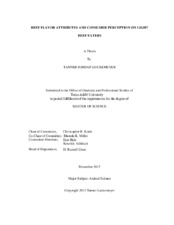| dc.description.abstract | Beef flavor is an important component of consumer acceptance and overall liking; however, it is complex and is composed of multiple attributes. Additionally, consumer opinions vary in factors that drive acceptance and it has been hypothesized that beef flavor drivers may differ for consumers who eat beef 1 to 2 times per week compared to consumers that eat beef more frequently. Our objectives were to create varying levels of positive and negative beef flavor attributes, measure these attributes with an expert trained meat descriptive flavor panel, identify the volatile compounds, and measure consumer liking for light beef eaters, and to understand the relationships between trained descriptive flavor attributes, volatile flavor compounds, beef chemical attributes and light beef eater consumer liking.
Levels of positive and negative beef flavor attributes were created by selecting Choice top loins, high pH top loins (pH ≥ 6.0), Select top sirloin butts, Choice tenderloins, Select bottom rounds, and Choice bottom rounds from 10 beef carcasses. Cuts were cooked to 58 °C or 80 °C utilizing a George Forman grill (steaks), food-service grill (steaks), or crock-pot (roasts). Trained beef descriptive flavor and texture attributes, consumer liking (n = 80 per city in Olathe, KS; State College, PA; and Portland, OR), and gas chromatography-mass spectrometry-olfactometry (GC-MS-O) were utilized to measure flavor. Warner Bratzler shear force; fatty acid composition; non-heme iron and myoglobin content; pH; and fat and moisture analysis were determined to understand chemical component relationships to the aforementioned beef flavor measures.
Cooking method, cut, and internal temperature impacted beef descriptive flavor and texture attributes and consumer liking ratings (P ≤ 0.05). Beef identity was higher in Choice tenderloin steaks, Choice top loin steaks, High pH top loin steaks and Select top sirloin steaks cooked on the grill to 80°C (P ≤ 0.05). Consumers rated Choice tenderloin steaks and Select top sirloin steaks cooked on the grill to either 58 or 80°C highest for overall, overall flavor, beef flavor, and grill flavor liking (P ≤ 0.05). As brown/roasted and fat-like increased, consumer liking increased (P ≤ 0.05). Aromatic volatile compounds (n = 248) were identified. Fifteen aromatic volatile chemicals accounted for 57% (P ≤ 0.05) of consumer overall liking. Partial least squares regression (r^2 = 0.87) showed relationships between trained descriptive flavor and texture attributes, consumer liking and volatile aromatic chemical compounds.
When beef flavor differed as determined by descriptive beef flavor attributes or aromatic volatile compounds, consumer liking was impacted for light beef eaters. Key aromatic volatile compounds or descriptive flavor attributes could be used to increase consumer overall liking for light beefeaters. | en |


